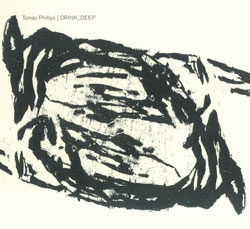
Rites of Spring were one of the Washington, DC-based Dischord label’s premier punk outfits of the early 80s, spewing out a raw, near-on “melodic” noise that, though drawn from a mere pittance of recordings, cemented a particular legacy for the hardcore brigade every bit as historical as their L.A. and NYC counterparts. How does this particular punk footnote relate to digital reductionist Tomas Phillips you ask? According to Phillips’ own commentary in the usually well-designed NVO envelope/sleeve, “Drink_Deep marks an effort to bridge the two distinct but inter-related milieus of the 80s Dischord era and the more recent practice of electronic minimalism, or microsound, both of which have relied upon aesthetic innovation and a modus operandi that is at once individualized and collaborative.” A bold statement, to be sure, one which doesn’t necessarily measure up to the respective deconstructions Phillips’ drinks deep of, but principles aside, this is still a pretty ingratiating piece of work.
Phillips no doubt takes his concept quite seriously, even down to reproducing (with a few slight tweaks) the cover images from Rites of Springs’ sole eponymous LP. But even the simplest understanding of microsound could never hope to explain Phillips’ at best tenuous links to his subject matter. Appreciate Drink_Deep as simply another splendid piece of well-designed tone art and you’re there. Split into just two lengthy pieces — the title track and “In Silence_Words Away”, both of which are named for tracks of RoS’ album — Phillips removes virtually all traces of the originals, as you might expect, right down to the subatomic level. Hence, shorn of context, this could be any of a dozen microsound recordings, but it helps that the man knows what he’s doing.
The title track begins with ghost entrails of hum (residue left over from a hundred burnt-out stacks of Marshall amps, perhaps?) over which the tiniest of pops glisten. Interweaving gusts of silence between the next series of tones, Phillips’ shows us what’s left of those mighty guitars after the thrash has been almost scrubbed clean: subterranean anti-noise, preening hi frequencies, the washed-out reverb of what feels like thousand-year-old church bells echoing out over a distant horizon. The second piece, a few minutes shorter in duration, is actually more “active” and enigmatic, as Phillips’ allows the metal luster of those guitars to shimmer and melt in bright afternoon sunlight, the sounds faint recollections of what they once were. Strangely enough, though bereft of punk’s abrasive, militant posturing, the effect remains imminently powerful — it’s the mirror image of punk, wrung through the digital ringer, and reflected off the gleaming silicon surfaces of cyberspace.
Comments and Feedback:



More Recent Reviews, Articles, and Interviews @ The Squid's Ear...


|

